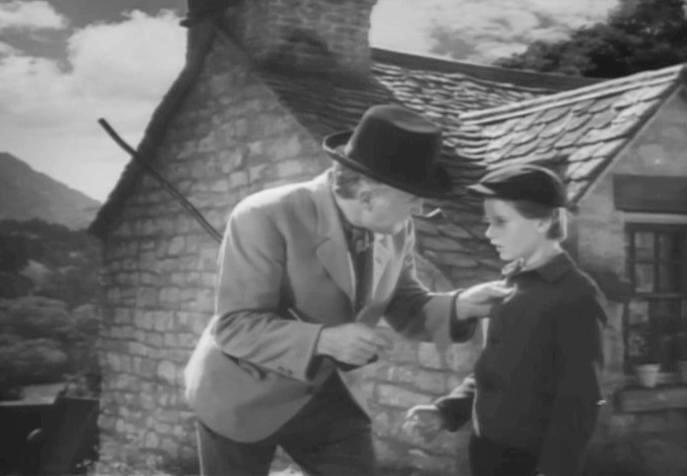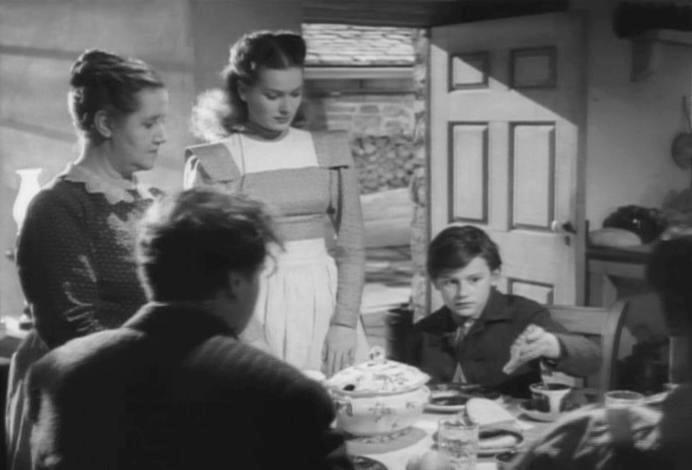
How Green Was My Valley (US, 1941)

Figure 1.--Here is a scene from "How Green Was My Valley", showing Huw with his father. He describes his beloved father, "Everything I ever learnt as a small boy came from my father, and I never found anything he ever told me to be wrong or worthless. The simple lessons he taught me are as sharp and clear in my mind as if I had heard them only yesterday."
|
|
"How Green Was My Valley" was a lovely little movie staring Roddie McDowell who plays Huw. The film was made in the States after Roddy was evacuated from England during the World War II Blitz. America had not yet entered the War. It probably would have never been made in England at the time as it is a rather critical look at the U.K., how English mine owners abused the miners--hardly in keeping with the patriotic theme of War-era films. Roddy provides a beautifully sensitive performance and I think it is best film, although he is probably better known for "Lassie Come Home" (1943) which he made 2 years later. Huw wears kneepants outfits with long socks. For church he wears a wide white collar. Huw is a Welsh coal miner's son, who is bright and sent to a National School. He is teased because of his Welsh accent and beaten by the school master. He gets sick after nearly drowning in an icy stream and is bedridden. The film was based on the novel by Robert Lewellyn. The film was made during World War II, but vefore America entered the War. There was at the time considderable sympathy for Britain and opposition to the NAZIs in Hollywood. Interestingly the plot of the film, which closely followed the book, represents a considerable criticism of British society, not exactly what you would expect in 1941. Yet the film closes with an optimistic tone, clearly leaving the impression that Wales and Britain were places with important values and people who should be defended.
Filmology
"How Green Was My Valley" was a lovely little movie made in the States after Roddy was evacuated from England during the World War II Blitz. It was directed by the great John Ford. Some film critics see it as his masterpiece. The film was named Best Picture of 1941. Donald Crisp won a Best Supporting Actor Oscar. Ford won his third Best Director Oscar, the second year running. He eon in 1940 for "The Grapes of Wrath", a film with a similar theme.
World War II
America had not yet entered the War. It probably would have never been made in England at the time as it is a rather critical look at the U.K., how English mine owners abused the miners--hardly in keeping with the patriotic theme of War-era films. The film was made during World War II, but before America entered the War. There was at the time considderable sympathy for Britain and opposition to the NAZIs in Hollywood. Interestingly the plot of the film, which closely followed the book, represents a considerable criticism of British society, not exactly what you would expect in 1941. Yet the film closes with an optimistic tone, clearly leaving the impression that Wales and Britain were places with important values and people who should be defended.
Book
The film was based on the best-selling novel by Robert Lewellyn (1906-83). One might think that Lewellyn was Welsh. Certainly no other book so beautifully depicts Wales. But he was English (with Welsh ancestors) and collected information for the book by talking with Welsh miners. He wrote other books with Welsh themes.
Setting
The film is sett in a Welsh village around the turn of the 20th century. The economy of the village turns around the coal mine. Ford wanted to shoot in Wales. The Blitz made that impossible so they had to build a replica village on the Twentieth-Century Fox lot.

Figure 2.--Here is a scene at the Morgan family dinner table.
|
|
Cast
The film had a very impressive cast. It focused on Roddie McDowell who plays Huw Morgan. Roddie was 12 years old and still new to America. He had already made several films, but in this film he delivered a truly masterful performance. Roddy provides a beautifully sensitive performance and I think it is best film, although he is probably better known for "Lassie Come Home" (1943) which he made 2 years later. Walter Pidgeon competentky played Mr. Gruffydd. Maureen O'Hara played Angharad Morgan. Donald Crisp of course playef Gwilym Morgan to perfection. Barry Fitzgerald played Cyfartha. There were many other fine performances. And of course a film about Wales had to include a choral group--the Welsh Singers.
Plot
The film tells the story of the Morgan familyh and is about family values and changing time. The cloes-knit Welsh family is making do with the father and older brither workibg in the mine. Economic conditions, however, change affecting the miners abd ukltimately the family. The film is narrated by a grown up Huw, the youngest pf seven children in a loving Welsh coal mineing family. Huw as a boy observes his village and family slowly desentegrate before his eyes. The narration is taken rom the text of the book. He describes his beloved father, "Everything I ever learnt as a small boy came from my father, and I never found anything he ever told me to be wrong or worthless. The simple lessons he taught me are as sharp and clear in my mind as if I had heard them only yesterday." Huw is a Welsh coal miner's son, but is set apart from his brothers by his academic abilities. Huw because he is bright is sent to a National School. He is teased y the English boys because of his Welsh accent and beaten by the school master. He insists on going down in the pits with his father when times get tight. He gets sick after nearly drowning in an icy stream and is bedridden.
Costuming
Huw wears kneepants outfits with long socks. For church he wears a wide white collar.
Reader Comments
A reader writes, "This movie tugged at my heart strings like few others. I was thoroughly
immersed in the lives of the Morgans and found myself especially drawn to young Huw's trials, tribulations, and triumphs. The scene where he taps his fork twice and sneezes before he is acknowledged by his father was poignant beyond belief. Despite the hardships and tragedies there is
also warmth and humor such as when family friends of the Morgans visit the schoolmaster after he had been especially harsh with Huw. The romantic aspect of the film is also well done by its primary principles, Angharad and the pastor. All in all the films does a magnificent job of
capturing the lives of a family in a bygone time and place."
Remakes
The book has been produced by the BBC for television, in 1960 and 1975. Each suffers in comparison to the film.
HBC

Navigate the Boys' Historical Clothing Web Site:
[Return to the Main Hm-Hz alphabetical movie page]
[Return to the Main alphabetical movie page]
[Return to the Main U.S. movie page]
[Introduction]
[Activities]
[Biographies]
[Chronology]
[Clothing styles]
[Countries]
[Theatricals]
[Topics]
[Bibliographies]
[Contributions]
[FAQs]
[Glossaries]
[Satellite sites]
[Tools]
[Boys' Clothing Home]
Created: 4:51 PM 2/23/2007
Last updated: 4:51 PM 2/23/2007




